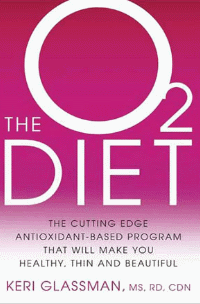 Keri Glassman, R.D. is the author of the super-popular new book The O2 Diet and a nationally-recognized nutrition expert. For years Keri has been a leader in advancing a “whole person” approach to health and wellness. She is also the author of The Snack Factor Diet.
Keri Glassman, R.D. is the author of the super-popular new book The O2 Diet and a nationally-recognized nutrition expert. For years Keri has been a leader in advancing a “whole person” approach to health and wellness. She is also the author of The Snack Factor Diet.
DietsInReview.com had an opportunity to interview Keri on her breakthrough plan that helps you lose weight and feel and look beautiful, inside and out. Here is what she had to say about her easy-to-do and incredibly healthy O2 Diet program.
Can you briefly describe what The O2 Diet is?
The O2 Diet is based on the ORAC (Oxygen Radical Absorbance Capacity) scale that measures how well a food protects against free radicals, which are the culprits behind many cancers, heart disease, and symptoms of aging. Consuming a diet rich in antioxidants has been linked to strengthening the memory, improving the skin, and aiding in weight loss. The O2 Diet is based on foods that will help you achieve your ideal weight and help you function better than you ever have. With the O2 Diet I am empowering you and giving you the tools to be your dietitian.
Why are antioxidants so important to our health?
Antioxidants are essential to our health because they help control the negative effects of free radicals on our bodies. Free radicals damage cellular structures such as DNA and cell membranes and this damage may cause cells to function poorly and mutate, which leads to many diseases and premature aging. Our body creates some antioxidants on its own, but we also need to get our antioxidants from the food we eat such as fruit, vegetables, nuts, grains, and even some protein sources like meats, poultry, and fish. This is where the O2 Diet comes into play.
Rather than counting carbs or calories, The O2 Diet counts ORAC points. What is an ORAC point?
An ORAC point is a measurement based on the ORAC scale, which was developed by the USDA and other researchers and measures a food’s potential to combat free radicals.
You suggest aiming to get in at least 30,000 ORAC points a day. That sounds like a lot. How hard is it to meet that daily requirement?
It is actually very easy to meet the daily requirement. Whether you start with the 4-day cleanse, the 2-week plan, or the DIY plan, the O2 Diet provides you with plenty of options you can choose to follow to meet the daily ORAC requirement.
Here is an example of a day on the O2 Diet:
Breakfast:
- 1 slice pumpernickel bread (500 ORAC points)
- Stonyfield Farm Light Smoothie
- Omega-3-enriched scrambled eggs (1 yolk, 3 whites) with1/2 tsp paprika on eggs (200 ORAC points)
- 1 cup green tea (3,000 ORAC points)
- Carrots and 2 tsp peanut butter with ½ teaspoon cinnamon (3,000 ORAC points)
Lunch
- 1 cup crudités of red and yellow peppers, carrots, zucchini (500 ORAC points)
- 1 cup lentil soup with ½ tsp cumin (15,800 ORAC points)
- 3 tbsp guacamole
Snack
- 1 cup green tea (3,000 ORAC points)
- Green apple (7,100 ORAC points)
- 2 tsp peanut butter (400 ORAC points)
Dinner
- 1 bunch sautéed broccoli rabe (sautéed in 2 tsp olive oil) (6,800 ORAC points)
- 1 cup red leaf lettuce with ½ cup carrots, ¼ cup mushrooms, ¼ cup red onions with 1 ounce lemon juice, 1 tsp black pepper, and kosher salt to taste (1,800 ORAC points)
- Pork tenderloin with 1 tsp thyme (200 ORAC points)
- 8 cups water with 1 ounce lemon juice per cup (3,200 ORAC points)
Total: 44,780 ORAC points
Is there a simple way to count these points or access a food’s value?
Although you can find numerous resources on the internet that will tell you a food’s ORAC value, they are based on 100 grams of food. In the O2 Diet I have converted these numbers into numbers based on portions we actually use, such as 1 cup of blueberries. I also have a portable ORAC chart and O2 calculator on The O2 Diet website. Also, I emphasize in the book that if you are eating according to the plan I lay out for you, you will be hitting your points- no math required.
Are there any foods in The O2 Diet that are off-limits and why?
Rather than focusing your attention on foods to avoid, the O2 Diet encourages you to eat plenty of foods rich in antioxidants – in other words, I focus on what you should be eating not what you shouldn’t. However, there are certain foods you should avoid, such as bad-for-you baked goods (think cakes, muffins, and cookies), processed sugar-free and fat-free fake outs, fried foods, processed meats with nitrates and high-fat meat, soft drinks, and hydrogenated fats.
If we don’t readily have access to the ORAC scale, are there certain fool-proof guidelines we can follow when trying to choose foods that pack the most antioxidant punch?
When you don’t have access to the ORAC-scale don’t worry! Eat a variety of fruits, veggies, healthy fats, and high fiber whole grains and lean proteins. Eat consistently through the day, drinks lots of water with lemon and green tea, and get plenty of sleep, exercise, and manage your stress.
Thanks so much Keri!
Here is DietsInReview.com’s complete review of The O2 Diet and two delicious recipes from the book:

